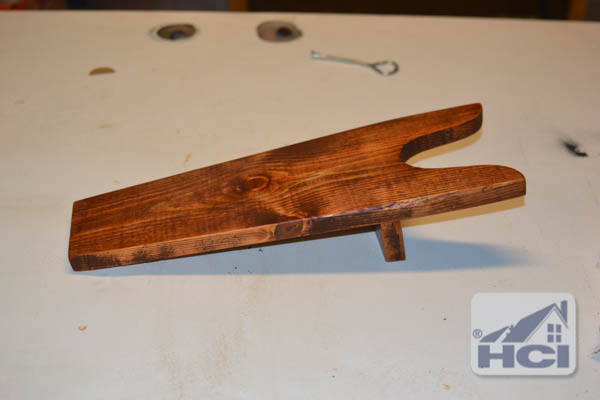Get Woodworking 2015: Boot Jack


Get Woodworking 2015: Boot Jack
Have you ever wanted to get into woodworking but weren’t sure where to start? There is a great event in the woodworking community that happens every year and it’s geared towards people like you, the brand new woodworker. It’s called Get Woodworking Week and every year more and more articles and projects are put together as a way to encourage and teach people woodworking skills. I’ve always been a lurker but this year decided to write up a quick how-to on an easy starter project. The project is a very simple boot jack. A boot jack is used to help you take off your boots without mucking up your socks. The boot jack uses a consumer level jig saw as the only power tool. Let’s get started.

About Jigsaws
Jigsaws are a power tool that uses reciprocating action of the blade and cuts on the up stroke. This pulls the workpiece up against the shoe of the saw but can also cause tear-out (splintering) on the face that is facing up. For this reason be sure mark and cut with the less desirable face of the board facing up. Some saws come with orbital action which moves the blade forward while it is on the up stroke. This helps the saw to cut faster. For this project the speed of the cut is less important then the quality. Dial down the orbital action to help minimize tear out.
Gather your tools and supplies
This project uses only one power tool, a jigsaw, and a minimum of other tools. If you don’t own a jig saw, a $30-$50 consumer model would work just fine for this. I’m using RYOBI’s variable speed orbital jigsaw but almost any saw in this category will work fine. Other tools needed are a pencil, ruler (at least 12″), clamp, wood glue, safety glasses, sandpaper, and a cup of coffee. We are starting with an 18″ piece of 1×6. I’m using standard construction grade pine but oak, maple, or just about anything else will work fine. If you buy your board at the big box stores I think the minimum size you can get in 1×6 is 3′ long. They will be happy to cut that board in half for you right in the store so you can have two 18″ boards. Make a boot jack for a friend if you like!
Mark the straight cuts
The boot jack’s finished length will be right around 16″ but we start with an 18″ board so that 2″ can be buzzed off an end right away to be used later as a foot to hold the business end in the air. Take your ruler and mark 2″ from the end of the board along parallel edges and connect the marks to form a straight line. Clamp down your board and cut off the 2″ piece and set aside.
Next measure in 1″ from the sides of the board along one end. Then go to the opposite end of the
Recent Posts
Framing Stick Nailer vs Coil Nailer
Which is Better a Stick Nailer or Coil Nailer? Framers have many choices in nailers…
How Many Roofing Nails Per Square of Shingles
Estimating How Many Nails for a New Roof When it comes to estimating materials for…
Composite / PVC Decking – Layout Tips & Advice
Composite / PVC Decking Layout Tips and Advice Composite and PVC decking have really changed…
Benefits of an ERV System (Energy Recovery Ventilator)
Benefits of ERV Systems (Energy Recovery Ventilator) If you're building a new home or doing…
Vermiculite Attic Insulation Abatement
Vermiculite Attic Insulation If your home was built before 1990 there is a chance it…
Nuisance Tripping of AFCI (Arc Fault) Circuit Breakers
Arc Fault (AFCI) Circuit Breakers Tripping Often An arc-fault circuit interrupter (AFCI) or arc-fault detection…


View Comments
Nice boot jack! Have you got a simple stool (4 legs) design?